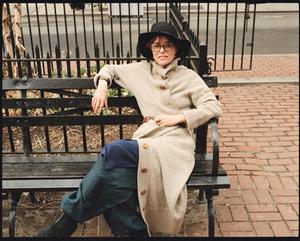
|
|
| photo: Clement Pascal | |
Your memoir is framed like a conversation between two people seated together on a flight. Did you imagine it being an airplane read?
There's a certain kind of conversation, a way of sharing that happens when you know you'll never see that person again. I really wanted to write something light, but intimate as well. And it started out like those coloring books that you used to get at airports: relax and meditate and color on your trip. I loved that idea because you do get into a certain kind of mindset. The book could be in the kitchen, it could be in the garage, it could be in the back of the car. A kid might like it. I wanted kind of like a hodgepodge and a self-published feel.
Like a conversation, the book moves more organically, not exactly chronologically, so I could pick it up and read about your childhood or your pottery or the chapter about learning yoga or about Nora Ephron or about....
Or about Shirley MacLaine. Yeah, it's a kaleidoscope. I guess that's probably why I wanted images to color, too. Remember when you would have books as a kid and you'd always go to the pictures first? You'd kind of circle around the book before reading it. It's me: an actor playing with paper. How much can I go with myself in this process and be as free as I want to be and then try to find a certain order? My editor helped me with that in the beginning.
 You call the book a self-mythologizing memoir--how does that form work?
You call the book a self-mythologizing memoir--how does that form work?Every memoir is self-mythologizing. I thought there was something funny and true about titling it that. This is me playing with the mythology of my childhood. I also love that Aristotle quote: "Give me a child by the age of seven, I'll show you the man." Here are things that come up inside our psyches. No matter how mundane they seem, they repeat themselves. Like, why are you an actor? I always loved going into old people's homes and sitting on their couches. It's storytelling and it's listening.
This book was written, I guess, pretty quickly. And intensely. I wanted to be playful with it. I loved The Power of Myth. I loved Joseph Campbell. And I was going through my family photographs and taking pictures myself and making collages and seeing how images dance with text. You can rip out a picture and put it on your wall. It's very 1990s fanzine DIY, which felt really true to my generation and to me.
When you fly places, do you talk to people next to you on the plane?
Of course. If they seem open. I'm always interested in that connection. I think it's a part of being a twin. You know it is this real desire to connect. You just have to have faith that in a time when we're talking less and less to each other, you'll connect. And it just feels like you're at the right place at the right time and not in this other zone where you're creating your reality from your social media or whatever.
Have you shared the book with your family?
My brother just came to visit, so I was able to show some of it to him and that was really great. Maybe I'll write something with him next, go down south. The south is so rich for storytelling. I mean it is really to be believed. My Aunt Peggy really did shoot my dad in between the eyes and the BB stuck and a teacher squeezed it out.
I'm sure the [family] will also have opinions, like that didn't really happen, or something, which really isn't the point. This is what I remember. They're southern Catholics, they're very religious. They loved and accepted me even being, what would you call it, the whore of Babylon? I think that's a good ending. --Kristianne Huntsberger, writer, storyteller and partnership marketing manager at Shelf Awareness

